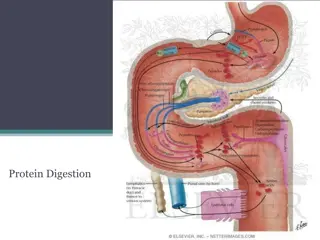Understanding the Titration of Weak Acids and Amino Acids
Titration is a crucial technique used to determine the properties of weak acids and amino acids. This process involves calculating pH values, degree of ionization, and understanding the ionization equilibrium of different acid-base systems. Various examples, including glycine hydrochloride, isoelectric glycine, and sodium glycinate, are explored to illustrate the principles of titration in this context.
Download Presentation

Please find below an Image/Link to download the presentation.
The content on the website is provided AS IS for your information and personal use only. It may not be sold, licensed, or shared on other websites without obtaining consent from the author. Download presentation by click this link. If you encounter any issues during the download, it is possible that the publisher has removed the file from their server.
E N D
Presentation Transcript
Titration of amino acids Amino acids are weak polyprotic acids . Neutral amino acids are (gly, ala, threonine ) are treated as diprotic acids . acidic amino acids (glu, asp,) are treated as triprotic acids . Basic amino acids (lys , arg , his ) are treated as triprotic acids . pHm is the pH at which the maximum total number of charges present. Glycine can be obtained in three forms : a) Glycine hydrochloride b) Isoelectric glycine c)Sodium glycinate
Titration of amino acids Example: Calculate the pH of a 0.1M solution of a) Glycine hydrochloride , b) Isoelectric glycine , c)Sodium glycinate Ka1 = 4.57 x 10-3 a) Glycine hydrochloride is a diprotic acid , the carboxylic group is a much stronger acid than the amino group , the pH of the solution is dependent exclusively by the extent the carboxyl group ionizes . Ka1 =[AA ] [H+] [ AA+1] , assume y = [ AA+1] that ionizes . Thus, y = [H+] produced, and y = [AA ] produced . AA+1remaining at equilibrium = [ AA+1] original - [ AA+1] that ionizes = 0.1 y (y)(y) 0.1 y=4.57 x 10-3 Thus, Ka1=
Titration of amino acids Since amount of y (value of y) is stronger than that can be ignored , Thus 4.57 x 10-4 - 4.57 x 10-3 y = y 2 y 2 + 4.57 x 10-3 y - 4.57 x 10-4 = 0.0 Y= ? ?2 4?? , where a = 1 , b = 4.57 x 10-3 , c = 4.57 x 10-4 2? Thus y = [H+ ] = 1.92 x 10-2 . pH = 1.72 . What is the degree of ionization of glycine hydrochloride in this 0.1M solution ? b) The pH of AA is the pI ( the pI is defined as that pH where the predominant ionic form is AA , so net charge on the amivo acid is zero .) So pH = pKa1 +pKa2 2 = 2 = 5.97 c)Sodium glycinate is a diprotic base , Both the unionized amino group and the carboxylate ion can accept a proton from water , but since the amino group is a much stronger base than the -carboxylate group , the pH of the solution depends almost exclusively on the extent to which amino group ionizes . 2.34 +9.6
Titration of amino acids For the amino group : Ka2=10 14 Kb1 =?w 10 9.6= 3.98 x10-5 For carboxylate group ; Ka1=10 14 Kb2 =?w 10 2.34= 2.19 x10-12 Kb1 = [OH-] [AA ] Kb1 = [OH ] [AA ] [ AA 1] Because the concentration of sodium glycinate is much larger than Kb1 thus y can be neglected from the dominator . = (y) (y) (y) (y) 0.1 ( y ) =
Titration of amino acids 3.98 x10-5 =y2 0.1, so y2 = 3.98 x 10-6 y = 3.98 x 10 6 y = 1.99 x 10-3 M , [OH-] = 1.99 x 10-3 M 1 x 10 14 1.99 x 10 3 ?w [H+] = = 5 x 10-12 M [OH ]= pH = -log[H+ ] = 11.3 .
Titration Curve of Neutral Amino Acids Amino acids are titrated in exactly the same manner as diprotic and triprotic weak acids . Neutral amino acid
Titration Curves of Amino Acids Information that can be obtained from a titration curve : 1-The number of ionizable groups in that amino acid , which can be detected from the number of titration stages in the curve , (or the number of pKa s or number of flat zones in the curve) . 2-Whether the triprotic amino acid is basic or acidic , that can be detected from the pKa2 . If it s value is closer to the value of pKa1 (that of the - carboxyl group ), then it is an acidic amino acid . If the value of it s pKa2is closer to the value of pKa3 (that of the - aminogroup ), then it is basic amino acid . 3- The pKavalues of the amino acid can be obtained from the curve which is equal to the pH value at the mid-point . 4-The isoelectric point , pI for each amino acid can be obtained from the curve by detecting the point where the amino acid is all in the zwitterion form (net charge = 0.0) the pH at that point is the pI . Or it can be obtained mathematically from ; pI = pKa1 + pKa2 ( in the case of a neutral amino acid ) . 2 In the case of triprotic amino acids , the pI is calculated from : pI = pKa1 + pKa2 (in the case of acidic amino acids ) . 2
Titration Curves of Amino Acids pI = pKa2 + pKa3 in the case of basic amino acids. 2 5-You can also determine from the curve the pH values at which the amino acid can act as a buffer . (the pH ranges 1 from the pH value of each midpoint).
How to Obtain a Titration Curves of Amino Acids No of moles of weak acid or a.a Calculate the first moles of OH by A= ?? ?? ???? ?? ???? ?? ?.? Calculate the second moles of OH added B= No of moles of weak acid or a.a + A Calculate the third moles of OH added C= No of moles of weak acid or a.a + B ???1
How to Obtain a Titration Curves of Amino Acids Sketch the pH curve for the titration of 100ml of 0.1M Glycine with KOH? Pka1=1.71, Pka2=9.6? No of moles of a.a = M*V = 0.1 * 0.1 =0.01 mole The first moles of OH by A= 0.01 / 1.71 = 0.005 The second moles of OH added B= 0.01 + 0.005 = 0.015 PI = (Pka1 + pka2)/ 2 =5.66
Plot the titration curve of Aspartic acid it has a volume of 100ml and0.1M When titrated with 0.1M KOH? Pka1=2.09, Pka2=3.86, Pka3=9.82?
Plot the titration curve of Lysine which has a volume of 200ml and 0.3M When titrated with 0.1M NaOH? ? Pka1=2.18, Pka2=8.95, Pka3=10.35?























